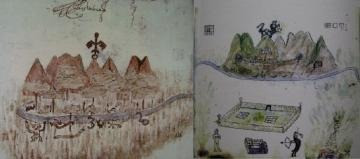Copy Link
Add to Bookmark
Report
Stuck In Traffic Issue 27

====================================================================
Stuck In Traffic
"Current Events, Cultural Phenomena, True Stories"
Issue #27 - November, 1997
Contents: ÿ
Diana's Death
The world's reaction to Diana's death reminds us of the strange
relationship between fame, beauty, and power.
On Fame and Virtue
Lessons learned from the life of Mother Teresa
Hear Them Roar, What Are They Saying
What's the significance of events like the Million Woman March and
The Promise Keeper's Gathering?
Edgy, Heavy, iNSULATED
A review of iNSULATED's debut album, Fence
A Day At The Races
NASCAR. It's not just for red necks anymore.
====================================
Current Events
Diana's Death
It's rarely recognized as such, but beauty is a powerful, driving
force. From the mythological stories like Helen of Troy, whose rare
beauty started wars and "launched a thousand ships." to modern
starlets like Marilyn Monroe who set the stage for our everyday pop
culture, our culture is full of examples of the power of the
beautiful. To dismiss a woman as "just another pretty face" is to
ignore history just about as far back as history goes.
Likewise, to dismiss the worldwide impact of Princess Diana's tragic
death simply on the grounds that she had nothing to offer "but a
pretty face" is to miss the point entirely. When hundreds of
millions of people, from every corner of the globe tuned into their
TV's to watch Diana's funeral, it wasn't just a lurid, onlooker
motivation. To dismiss Diana as a nothing more than a media creation
hyped up by the paparazzi into a bigger than life image is to mistake
cause and effect.
Yes, Princess Diana was largely a media creation. Yes, she had
little to offer the world other than her beautiful, down-to-earth
smile. Yes, her claim to fame is based almost entirely on the fact
that she married into royalty. But royal connections can't explain
Diana. After all, her popularity easily eclipsed that of the Queen
and the rest of the royal family. Her royal connections put her into
the public spotlight, but it was her beauty that captured the world's
attention.
But as Helen of Troy, Marilyn Monroe, and Princess Diana all found
out, it takes a strong woman to bear the burden of a pretty face.
When the pubic spotlight first fell on Diana, we saw a young,
overwhelmed woman, frightened and unsure. But she stood up to the
demands of being a fairy tale Princess and by the time she married
Prince Charles her command of our attention was sealed.
During her marriage, Diana alternated between showing signs of
breaking down under the pressure of the public spotlight and basking
in it. We watched her perform the duties expected of royalty by
speaking at all the right charities, attending all the right events,
saying all the right things. But it was always Diana's personal life
that interested us. The world was more interested in her struggles
with bulimia, her rocky marriage, and her conflicts with Prince
Charles over how to raise their sons. And of course there was her
continued struggle for privacy against the incessant attention paid
to her by the paparazzi.
It wasn't until her divorce from Prince Charles that Diana finally
started showing signs of being the master of her beauty instead of a
victim of it. The royal family was unable to show Diana how to use
her fame and beauty effectively. In fact, Diana's death has showed
that the royal family is a much a victim of their inability to deal
with public scrutiny as any other fallen beauty queen. But where the
royal family failed, Diana's assistants and advisors succeeded.
They taught Diana that the media attention that had caused her so
much stress in the past had now become her only asset. And she
learned how to use her fame and beauty as an asset to command the
media attention and use it as a tool. One may disagree with the
organizations and charities that she publicized and promoted. For
example, one might complain that her campaign against land mines was
perhaps just a little too much of a photogenic publicity campaign.
But it's indisputable that the month's after Diana's divorce were her
most successful. With minimal incident, she managed to continue to
raise her sons in the way she thought best while successfully using
the media to promote well deserving causes. In some sense, she was
the ultimate working Mom, the most popular member of the royal family
(even having been kicked out of it), and the world's most beautiful
and eligible woman all at once.
Whether or not it is ever proven that Diana's death was a tragic
result of the relentless pursuit of the media, the worldwide
outpouring of grief shows that Diana had finally mastered her fame
and beauty and used it rather than allowing herself to be destroyed
by it. It's too early to tell if her sons are going to inherit the
worldwide attention that their mother did or if they will become
merely members of the royal family, but hopefully they will learn
this lesson from their mother, Diana, Princess of Wales.
====================================
Current Events
On Virtue and Fame
Since the death of Mother Teresa, some people have said that it is
unfortunate that Mother Teresa died so shortly after the car accident
that killed Diana. Despite being honored with a full state funeral
by the Indian government, despite her funeral being attended by
dignitaries from around the world, despite the worldwide broadcast of
her funeral, they say that the tribute paid to Mother Teresa was
inadequate. As the theory goes, Mother Teresa didn't get the proper
tribute that she deserved because the world's attention was still
focused on Diana's death.
These people have no idea what they are talking about.
Princess Diana deserved and received the tribute of a beautiful,
famous woman. Mother Teresa deserved and received the tribute of a
virtuous woman. Comparing their respective tributes and comparing
the world's reaction to their deaths is unfair to both Princess Diana
and to Mother Teresa. If Teresa's tribute was something less than a
worldwide media circus, it was more dignified for the same reason.
Mother Teresa was drawn to the work of the Catholic Church at an
early age. Born as Agnes Gonxha Bojaxhiuin 1910 in Macedonia of
Albanian parents. She moved to Ireland to join the Order of the
Sisters of Our Lady of Loreto when she was only 18. She was assigned
to teach at a girls High School in Calcutta and it was there that she
discovered her mission. She became terribly distressed at the many
sick and dying people she saw in the streets and she has said of that
time:
"I realized that I had the call to take care of the sick and dying,
the hungry, the naked, the homeless - to be God's Love _in_action_ to
the poorest of the poor. That was the beginning of the Missionaries
of Charity."
She was granted permission to leave the Loreto congregation and
establish her now worldwide Missionaries of Charity.
The Missionaries of Charity believe firmly in going directly to the
problem. They aren't lobbyists for government action. They aren't
shame mongers to the rest of the world. They go directly to those in
need and help them. Their work is not pretty. Every day, they have
to confront the most unpleasant sights that the world has to offer.
People starving in the street. People dying of extremely unpleasant
disease like leprosy. In the book, _Something_Beautiful_for_God_,
Mother Teresa described the first time she helped a dying woman in
the streets and how her mission started:
"The woman was half eaten up by rats and ants. I took her to the
hospital, but they could do nothing for her. They only took her
because I refused to go home unless something was done for her.
After they cared for her, I went straight to the town hall and asked
for a place where I could take these people, because that day I found
more people dying in the street. The employee of health services
brought me to the temple of Kali and showed me the "dormashalah"
where the pilgrims used to rest after they worshipped the goddess
Kali. The building was empty and he asked me if I wanted it. I was
very glad with the offer for many reasons, but especially because it
was the center of prayer for Hindus. Within 24 hours we brought our
sick and suffering and started the Home for the Dying Destitutes."
It takes an immensely strong person to care for these people but
Mother Teresa and the Missionaries of Charity found strength and
satisfaction in this work that the rest of the world can only at best
tolerate. As Mother Teresa said:
"I see God in every human being. When I wash the leper's wounds, I
feel I am nursing the Lord himself. Is it not a beautiful
experience?"
Of course there are many people doing charitable work throughout the
world, both inside and outside of the Catholic Church. What set
Mother Teresa apart from the crowd was her focused dedication to her
work that never faltered, never wavered for her entire life. What
set Mother Teresa apart was that she directly confronted the worst
problems in the world head on without letting it get her down.
Thoreau wrote in "Civil Disobedience" that "There are nine hundred
and ninety-nine patrons of virtue to one virtuous man." Perhaps that
partly explains the worldwide tribute she received after her death.
Perhaps there are 999 people talking about "helping the poor",
perhaps there are 999 people voting for "helping the sick and dying",
perhaps there are 999 people sympathizing with the lepers plight for
every one virtuous person actually doing something about it. Because
if nothing else can be said of Mother Teresa, she was a virtuous
woman. One doesn't have to be Catholic, or even religious, to
recognize that.
And in addition to giving hope to the sick and the poor, Mother
Teresa's death gives hope to everyone else in the world because her
life is proof that one does not have to be rich to accomplish great
goals. One does not have to be famous to have an impact. Anyone can
change the world through virtue and dedication.
====================================
Current Events
Hear Them Roar, What Are They Saying?
On Saturday October 25th, 1997 hundreds of thousands of women,
perhaps more than a million of them, converged on Philadelphia for
the much anticipated "Million Woman March".
While police public information officers, the media, and African
American Activists squabbled over whether or not there were actually
a million women in attendance, the real message of the gathering has
been largely overlooked.
The march was organized by Phile Chionesu and Asia Coney, two
African-American ladies in Philadelphia. And while not exactly new
to activism, they aren't career activists either. In a large sense,
they are ordinary women inspired by the Nation of Islam's Million Man
march last year.
The official theme of the march, was "Repentance, Resurrection, and
Restoration," which is perhaps too close to the theme of Men's march
to disassociate itself with Louis Farrakahn. And like the Million
Man march last year, the speechifying had an unusually mixed message.
While speakers spoke in general terms about the power of their
collective strength, the specifics preached about empowerment of the
individual.
They spoke of recapturing their inner city neighborhoods from drug
dealers by forming community watches. They spoke about confronting
the bad elements of society head on, and not tolerating violence.
They spoke of revitalizing local businesses in those communities by
starting new businesses and investing in locally owned businesses.
They spoke of the importance of being their own bosses and being in
control of their own financial destiny.
They spoke of mentoring teenage girls, which in effect means simply
taking an interest not only in ones own children, but taking a
concerned interest in the well being of all the children in the
neighborhood.
They spoke of establishing independent schools to replace the failed
government schools. And why not? More and more people are learning
that it doesn't take a rocket scientist to educate children. It
mostly takes time, patience, and dedication. They spoke of helping
recently released prisoners reintegrate themselves into society.
The list went on and on. And there wasn't a single bad suggestion in
the whole lot. And yet there was a discomforting tenor to the
gathering as well.
Take for example, the singing of "Lift Every Voice And Sing," better
known as The Black National Anthem. It's a beautiful, spiritual
song. But one can't help but wonder how the Black National Anthem
relates to everything else, especially to the nation as a whole. The
lyrics don't help matters much. Take for example, the third verse:
God of our weary years,
God of our silent tears,
Thou who has brought us thus far on the way;
Thou who has by Thy might
Led us into the light,
Keep us forever in the path, we pray.
Lest our feet stray from the places, Our God, where we met Thee,
Lest, our hearts drunk with the wine of the world, we forget Thee;
Shadowed beneath Thy hand,
May we forever stand.
True to our GOD,
True to our native land.
Since it's known as The Black National Anthem, one can't help but
wonder about the abiguity of the last line.
It's a nit that wouldn't be worth picking at if the other messages
coming out of the Million Woman march weren't also troubling.
Phile Chionesu was quoted by the Reuters news service saying, "We
want to prepare our women, no matter what their status in life, to
look at how we can begin to invest as black women and how we can
begin to vote in blocs as black women."
One of the keynote speakers was Rep. Maxine Waters (D-California).
This is the woman that has been spearheading charges against the CIA
that they are responsible for introducing crack cocaine into inner
city neighborhoods. To cheering crowds she proclaimed, "After today,
we will never be the same....America be placed on notice. We know
who we are. We understand our collective power. Following today, we
will act on that power."
Again, this is more than a little ambiguous. Is this a threat or a
promise?
The ambiguity reflects a crossroads that African Americans are going
to eventually have to choose. Will their movement go down the path
of confrontation and special interest group politics? Or will their
movement go down the path of teaching empowerment, inspiration, and
responsibility?
In a large sense, this is a crossroads many people in America face as
our nation becomes more and more diverse. The recent gathering of
the Promise Keepers in Washington was equally ambiguous in its tenor.
Were they preaching group politics or self-improvement? The Promise
Keeper's "Stand In The Gap Covenant" sent mixed signals. On the one
hand, the covenant makes statements like:
"We covenant by Your grace to love and serve our wives and children.
We commit to give them first priority in our prayers and schedules.
Today, each of us declares, `As for me and my house, we will serve
the Lord.' Where we have used our masculinity against others, we now
commit to honor all women and value all human life through our words
and in our actions."
And later in the same document:
"We covenant by Your grace to pray for and to facilitate unity in the
body of Christ. Where our pride, insensitivities and prejudice have
divided the Church, we commit to seek forgiveness, understanding, and
reconciliation."
But in the same document there are statements like:
"We covenant by Your grace to pursue vital relationships with a few
other godly men for the purpose of encouraging one another toward
love and good deeds."
How can this be interpreted as anything other than collectivist group
action?
Nothing but good can come from a million African-American women
returning home from their march, charged up and inspired to tackle
the problems in their community. Nothing but good can come from a
million Christian men heading home from D.C. committed to
revitalizing their commitment to their families and communities.
The potential danger in events like The Million Man March, the
Million Man March, or the Promise Keepers Gathering is not in their
specific goals. Indeed, they should be applauded for their
initiative. The danger in these events is that they can lead people
to believe that they must think and act as a group, that they must
put their own judgements aside in favor of the collective. It's
events like these that can lead to the worst kind of demagoguery.
====================================
Cultural Phenomena
Edgy, Heavy, iNSULATED
The L.A. based trio named iNSULATED have just released their first
nationally distributed album called FENCE; and when you slide it into
your CD player, the first question that will pop into your head is,
"Are these guys just another Red Hot Chili Peppers clone?" But by the
time you listen to the album's closing track, it won't matter what
the answer is.
By including "Find Your Sugar" as their first track, the band is
inviting, begging even, to be compared the Red Hot Chili Peppers.
"Find Your Sugar" mixes multiple, competing lines of tempo that
capture the full steam ahead, barely under control mood with a heavy
metal singsong rap. "Find Your Sugar" will likely garner then
considerable air play, at least on the college stations, on those
merits alone.
The track that has "mass market, hit single" written all over it is
"Thread." In other words, it's the track that's the most like other
rock songs you've heard over the past few years. You know the drill;
standard instrumentation; standard form traditional rock theme. (How
am I gonna find the time to be a big rock star and still have time
for love?) And while it's not exactly upbeat, but there's a sense of
hope in it that makes it a satisfying listen. It's a competently
performed song, but it's not unlike stuff you haven't heard before.
Heck, the guitar work is even reminiscent of U2's early work.
Clearly iNSULATED is trying to cover their bases. "Find Your Sugar"
to invite comparisons to the Red Hot Chili Peppers, and "Thread" in
order to have a single that can be played on your generic Rock
Station du jour.
Don't hold that against them. On Fence's other tracks, iNSULATED
proves that aren't just chasing after demographics. iNSULATED has
become their own musical masters and carved out a sound they can call
their own.
Fence is all about being on the edge of major changes, major
decisions. The critical moments on life and the stresses of those
decisions that can seem to make seconds stretch into hours. The
music, at its best, feels like important decisions bearing down on
us. Something big is going to happen and you don't know quite how
it's going to turn out or what you're going to decide and are you
going to make the right decisions or not? The music is a reflection
of the chaos that fills us when we're on the edge of making big
decisions.
"Waiting On A Check" starts out with a mellow musical groove,
reflecting a level of self-certainty, but the music gets
progressively more complex, distorted and heavy as Gabriel Careful
sings about the challenges of stepping outside of "a single file
world." "Frozen Over" also showcases iNSULATED's ability start with a
simple line of music and pile layers of feedback and complexity on
top of it until your head is swimming.
The best tracks on Fence are the full force, frontal assaults like
"Ooga Booga Baby", "Show No Mo", and "Step Off." iNSULATED mixes
postmodern lyrics, heavy guitar and drum work, and just the right
amount of electronic mixing, with the confidence to combine multiple,
competing lines of music into the same song to create an energetic,
edgy, panoramic sound.
Fence is distributed through Navarre. iNSULATED's web site is
located at http://www.insulated.com/
====================================
True Story
A Day At The Races
I admit it, I'm a media junkie. I don't know how it happened. Maybe
it's an occupational hazard of being a programmer; I often find
myself dividing my attention between two or three computers at a time
as a regular part of my job. Or maybe I'm just a product of these
media-laden times.
Whatever the reason, I'm into information overload big time. Most
evenings you can find my in my home office, surfing the net, watching
the TV out of the corner of my eye (usually CNN or CSPAN) listening
to the radio. My house is full of magazines piled up waiting to be
read. I'm subscribed to no less than 20 e-mail based net
publications and one of my favorite hobbies is reading online
newspapers from places like Venezuela, St. Petersburg, and Japan.
But recently my addiction reached an all new level of depravity at a
very unlikely event. A NASCAR race.
At first glance, you wouldn't think that stock car racing was much of
an event, especially if your only experience with stock car racing
has been to channel surf past a race on TV. All you see on TV is the
one or two cars on the lead lap and since the cameras are following
the lead cars you don't even get a good feel for how fast they are
running. Heck, you don't even get to see the drivers except during
their commercials.
But when you go to the race and watch it first hand, the experience
is totally different. First of all, outside the race track every
driver has their mobile tractor trailer displays selling every
imaginable souvenir you can imagine. Caps, T-Shirts, pins, posters.
Basically, everything you can put a driver's face, logo, or car
number on is for sale.
But these one man circuses are also full of high tech toys, You can
buy cell phones, pagers, CB radios and all kinds of radio equipment.
But the best thing of all is that for about $30, you can rent a radio
scanner and set of headphones for the race.
What for? Well, the pit crews and no longer use old fashioned
chalkboards and signs to communicate with the drivers. It's all done
with 2-way radios now. With your scanner and headset, you can listen
to all the radio communications between the drivers and the pit
crews.
Listening to these conversations, you find out a lot more abut what's
going on in the race. Who needs new tires? Who bumped who on the
track? Which cars have the right suspension for the days race.
Where are the bad spots on the track. It's a constant stream of
chatter.
And watching the track live, you see the all of the cars at once and
you get a much better indication of which are the good drivers and
which are the not so good drivers. And usually the cars are spread
out all over the track, so you are constantly watching the cars
jockey for position.
NASCAR. It's not just for red necks anymore. It's an information
junkie's dream.
====================================
About Stuck In Traffic
Stuck In Traffic is a monthly magazine dedicated to evaluating
current events, examining cultural phenomena, and sharing true
stories.
Why "Stuck In Traffic"?
Because getting stuck in traffic is good for you. It's an
opportunity to think, ponder, and reflect on all things, from the
personal to the global. As Robert Pirsig wrote in _Zen and the Art
of Motorcycle Maintenance_, "Let's consider a reevaluation of the
situation in which we assume that the stuckness now occurring, the
zero of consciousness, isn't the worst of all possible situations,
but the best possible situation you could be in. After all, it's
exactly this stuckness that Zen Buddhists go to so much trouble to
induce...."
Submissions
Submissions to Stuck In Traffic are always welcome. If you have
something on your mind or a personal story you'd like to share,
please do. You don't have to be a great writer to be published here,
just sincere.
Contact Information
All queries, submissions, subscription requests, comments, and
hate-mail about Stuck In Traffic should be sent to Calvin Stacy
Powers preferably via E-mail (powers@ibm.net) or by mail (2012
Talloway Drive, Cary, NC USA 27511).
Copyright Notice
Stuck In Traffic is published and copyrighted by Calvin Stacy Powers
who reserves all rights. Individual articles are copyrighted by
their respective authors. Unsigned articles are authored by Calvin
Stacy Powers.
Permission is granted to redistribute and republish Stuck In Traffic
for noncommercial purposes as long as it is redistributed as a whole,
in its entirety, including this copyright notice. For permission to
republish an individual article, contact the author.
E-mail Subscriptions
E-mail subscriptions to the ASCII text edition of Stuck In Traffic
are free. Send your subscription request to either address listed
above.
Print Subscriptions
Subscriptions to the printed edition of Stuck In Traffic are
available for $10/year. Make checks payable to Calvin Stacy Powers
and send to the address listed above. Individual issues are
available for $2.
Archives
The ASCII text editions of Stuck In Traffic is archived on the
internet by etext.org at the following URL:
http://www.etext.org/Zines/ASCII/StuckInTraffic/
The Web based version of Stuck In Traffic can be found at the
following URL:
http://www.StuckInTraffic.com/
Trades
If you publish a `zine and would like to trade issues or ad-space,
send your zine or ad to either address above.
Alliances
Stuck in Traffic supports the Blue Ribbon Campaign for free speech
online. See <URL:http://www.eff.org /blueribbon.html> for more
information.
Stuck In Traffic also supports the Golden Key Campaign for electronic
privacy and security. See <URL:http://www.eff.org/goldkey.html>
====================================================================



















